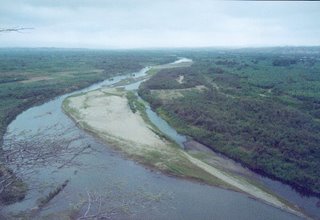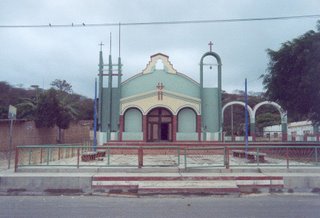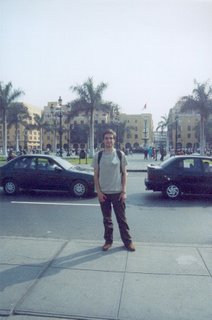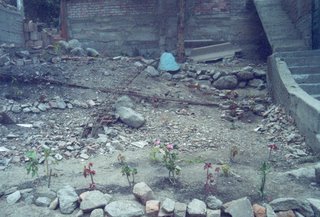Images and review of these months


San Juan de Virgen (R). This is a semi-urban community about 10 minutes from Tumbes and 15 minutes from my site. Site of another volunteer from Peru 8 (Hey Lauren!) whom I will collaborate with and hang out with when times are tough! Both of us are Salud Comuntaria volunteers but we work at different health centers. We are talking about making radio appearances and spots for health promotion issues among other ideas that we can share.
Above (L) is Rio Tumbes. Home sweet home for the next two years. (L) A community near our training facility and about an hour outside of Lima. Part of training included organizing and involving a sector of the community (which consisted of roughly 10,000 residents) in a project. My group did a charla (small workshop) and reclaimed a dump site/lot with a high school class. We did our best at promoting the idea of long term responsibility for the care and maintence of this spot. The students were really into this project and when I went back a few days later to take this picture, the garden was freshly watered. A good start! We worked at a local vivero (nursery) to solicit a donation of 72 plants for the project.
(L) A community near our training facility and about an hour outside of Lima. Part of training included organizing and involving a sector of the community (which consisted of roughly 10,000 residents) in a project. My group did a charla (small workshop) and reclaimed a dump site/lot with a high school class. We did our best at promoting the idea of long term responsibility for the care and maintence of this spot. The students were really into this project and when I went back a few days later to take this picture, the garden was freshly watered. A good start! We worked at a local vivero (nursery) to solicit a donation of 72 plants for the project. Lima, Peru. (L) Three blocks away from the Plaza de Armas.
Lima, Peru. (L) Three blocks away from the Plaza de Armas. I exist! Plaza de Armas. Lima. (L) Celebrated my final language exam by going to the Centro and by finding an Irish Pub in Miraflores!
I exist! Plaza de Armas. Lima. (L) Celebrated my final language exam by going to the Centro and by finding an Irish Pub in Miraflores!
Another angle of the reclaimed (in process!) lot. One of the students kept finding "Intis" which were the currency of Peru until inflation became so high that on July 1 1991 the Inti was replaced with an exchange rate of 1,000,000 : 1 for the the new currency "Nuevo Sol" (New Sun).
These past few months have allowed me the opportunity to explore some of the political, ecological, economic, public health and cultural dimensions of life here. A representative that I heard speak from the NGO Pathways (which partners with Peace Corps as well as USAID) provided a salient metaphor for these social dimensions as representing different sides of a rubix cube. Moving one side affects the compostion and appearance of the others. All are interrelated, therefore all dimensions must be taken into account with every maneuver.
In this vein, the following is a very brief synopsis of information gathered from my own training materials, the USAID June 2005 Country Report, World Health Organization, El Comercio, Etiqueta Negra and the Carnegie Endowment for International Peace (carnegieendowment.org).
Population: 27,544,305 (2004)
% Urban: 73.5% (2002)
Life Expectancy: 69.2 (2004)
Physicians per 1000: 0.93 (World Bank, 1997)
Adult Literacy Rate: 85%; Women-80.3%; Men 91.3%
Access to Improved Water Source (rural): 62% (2000)
Access to Improved Water Source (urban): 87% (2000)
Access to Improved Sanitation facilities (rural): 49%
Access to Improved Sanitation facilities (urban): 79%
Women ages 20-24 who gave birth before age 20: 30.1%
Estimated number of people living with HIV (adults, children): 82,000 (2003)
TB: 54,164 cases (2002), Detection rate: 84%
Computers. According to the National Statistics and Information Institute (Instituto Nacional de Estatidistica e Informacion) in 2005 6.8% of households had computers, up from 4.4% in 2004. Telefonica, a Peruvian phone and technology company reported that at the end of 2005, 20% of internet users reported having a personal computer, while the remaing 80% used internet cabinas (The Economist, "Global Technology forum," Growth of E-Commerce in Peru).
Alcohol abuse and dependency is identified as a major health problem. According to the 2004 WHO world alcohol consumption report, 28.8% of Peruvian adolescents (ages 12-19) drink either daily or once a week. The rate for adults of alcohol dependency is 10.6%; 17.8% of men and 4.3% of women compared to 7.3% of adults in the US (SAMSA, 2004).
Poverty Indicators. 50% of Peruvians live in poverty which is the equivalent of $58/Mo., while 20% live in extreme poverty which is $32/Mo. Nearly 80% of adults in socioeconomic levels D, E (pobreza, pobreza extrema) have not either not begun or completed secondary education in the greater Lima area.
Economy. International Monetary Fund (IMF) states that in 2005, Peru had the lowest rate of inflation in Latin America, at 1.8%. Peru's economic growth rate has been 6% for the past 6 years. U.S. growth rate is 3.2% for 2005, according to the CIA world fact book. U.S. trade with Peru represents 1% of our trade. Peruvian trade with the U.S. is represented by 26% of their trade.
Congress is currently debating the approval of the TLC (Tratado de Libre Comercial) between the U.S. and Peru which aims to bolster private investment, ease of trade, secure democratic relations in Latin America, diminish narcotrafficking and stimulate markets. Risks include lack of regulation and monitoring of child labor abuses in Peru; economic benefits not reaching and/or not being distributed adequately among the poor; exacerbated or worsened management of labor conditions in Peru; impact on small farmers of accessibility of agricultural corporations and business. Potential benefits include opening of new markets in Peru and for Peru/U.S. ; furthering of economic growth, heightened standards of labor and production assuming regulations, training where appropriate and responsible practices are implemented and monitored on the ground; the documented improvements in quality of life associated with strong economies and markets. Discourse often surrounds the issue of asymetry between the U.S. economy and Peruvian economy along the lines of the aforementioned disparities in levels of trade.

4 Comments:
Miquel, the garden near the High School looks very nice. Bet there were a lot of rocks to move to acquire that landscape. Hope the students/community keep the grounds up & allow the plants to bloom & flourish. Much luck to you on your journey to Tumbes. Amor, Mama i Papa
On November 19 in response to the 11/12 blog, Grandma M says:
Dear Mike, Jean and I were eagerly reading your recent blog and thoroghly enjoyed it. It sounds grueling and difficult but hopefully time will pass and soon you'll establish yourself in a routine you can live with. The sooner the better I'm sure. I pray that you'll get what you want and need to make your life there pass by quickly. I do agree you need to change your diet. I guess compare to what's on your menu, vegetarian is a much better choice.
We are packing to visit Jean's new great granddaughter over Thanksgiving Holiday. I've never been to NH before except to pass through it. It promises to be exciting. We return 11/26 so perhaps I'll have some other tidbits for you. Until then, Jean and I wish you a Happy Thanksgiving - however you may celebrate it in Peru. (Nothing compared to home. Thinking of you with all our love,
Gram and Jean.
Dear Miguel! Another wonderful journey unfolds as you realy your thoughts about your new life. It sounds like excitement is starting to take over as you see some progress as with the garden. I printed some pictures from you blog as well as the ones Melissa sent you so I can show Grandma. I also sent that link to Tom and Di and I will also send it to Joe. You look good, but thin.
I can't tell enough how proud and happy I am to have you in my life.
Feliz na Vidad, Love, Mom & Dad
Post a Comment
<< Home